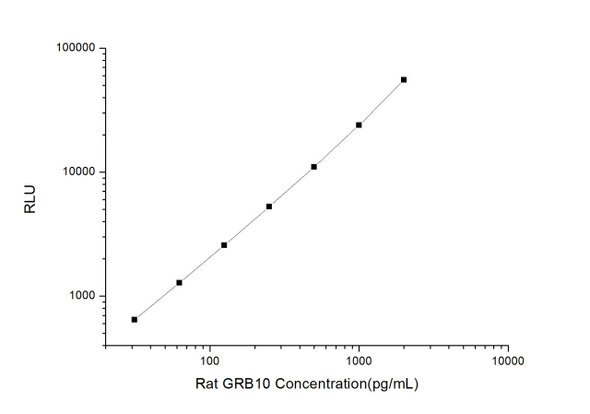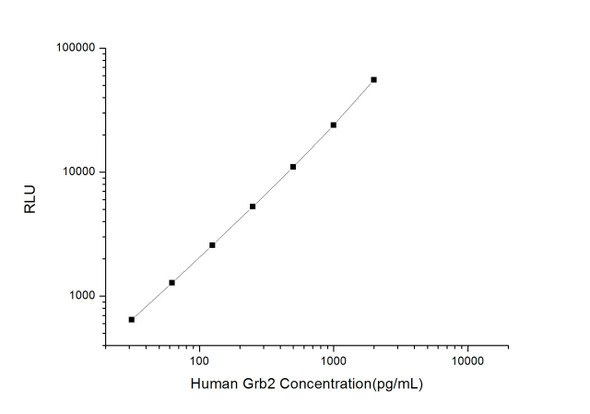Human Cell Biology ELISA Kits 5
Human Grb10 (Growth Factor Receptor Bound Protein 10) CLIA Kit (HUES01062)
- SKU:
- HUES01062
- Product Type:
- ELISA Kit
- ELISA Type:
- CLIA Kit
- Size:
- 96 Assays
- Sensitivity:
- 37.5pg/mL
- Range:
- 62.5-4000pg/mL
- ELISA Type:
- Sandwich
- Reactivity:
- Human
- Sample Type:
- Serum, plasma and other biological fluids
- Research Area:
- Cell Biology
Description
| Assay type: | Sandwich |
| Format: | 96T |
| Assay time: | 4.5h |
| Reactivity: | Human |
| Detection method: | Chemiluminescence |
| Detection range: | 62.50-4000 pg/mL |
| Sensitivity: | 37.50 pg/mL |
| Sample volume: | 100µL |
| Sample type: | Serum, plasma and other biological fluids |
| Repeatability: | CV < 15% |
| Specificity: | This kit recognizes Human Grb10 in samples. No significant cross-reactivity or interference between Human Grb10 and analogues was observed. |
This kit uses Sandwich-CLIA as the method. The micro CLIA plate provided in this kit has been pre-coated with an antibody specific to Human Grb10. Standards or samples are added to the appropriate micro CLIA plate wells and combined with the specific antibody. Then a biotinylated detection antibody specific for Human Grb10 and Avidin-Horseradish Peroxidase (HRP) conjugate are added to each micro plate well successively and incubated. Free components are washed away. The substrate solution is added to each well. Only those wells that contain Human Grb10, biotinylated detection antibody and Avidin-HRP conjugate will appear fluorescence. The Relative light unit (RLU) value is measured spectrophotometrically by the Chemiluminescence immunoassay analyzer. The RLU value is positively associated with the concentration of Human Grb10. The concentration of Human Grb10 in the samples can be calculated by comparing the RLU of the samples to the standard curve.
| UniProt Protein Function: | GRB10: an adaptor protein that inhibits insulin-stimulated IRS-PI (3)K-Akt signaling pathway by disrupting the association of IRS with the insulin receptor. Also binds activated PDGFR and EGFR. Preferentially localizes to the mitochondria, modulating the anti-apoptotic activity of mitochondrial Raf-1. Can translocate to the plasma membrane and lamellipodia. Three alternatively spliced isoforms have been described. |
| UniProt Protein Details: | Protein type:Adaptor/scaffold Chromosomal Location of Human Ortholog: 7p12. 2 Cellular Component: cytoplasm; plasma membrane; cytosol Molecular Function:protein binding; SH3/SH2 adaptor activity; insulin receptor binding Biological Process: negative regulation of glucose import; negative regulation of Wnt receptor signaling pathway; insulin-like growth factor receptor signaling pathway; insulin receptor signaling pathway; negative regulation of insulin receptor signaling pathway; negative regulation of phosphorylation; positive regulation of phosphorylation; positive regulation of vascular endothelial growth factor receptor signaling pathway; response to insulin stimulus; negative regulation of glycogen biosynthetic process |
| NCBI Summary: | The product of this gene belongs to a small family of adapter proteins that are known to interact with a number of receptor tyrosine kinases and signaling molecules. This gene encodes a growth factor receptor-binding protein that interacts with insulin receptors and insulin-like growth-factor receptors. Overexpression of some isoforms of the encoded protein inhibits tyrosine kinase activity and results in growth suppression. This gene is imprinted in a highly isoform- and tissue-specific manner, with expression observed from the paternal allele in the brain, and from the maternal allele in the placental trophoblasts. Alternatively spliced transcript variants encoding different isoforms have been identified. [provided by RefSeq, Oct 2010] |
| UniProt Code: | Q13322 |
| NCBI GenInfo Identifier: | 6166186 |
| NCBI Gene ID: | 2887 |
| NCBI Accession: | Q13322. 2 |
| UniProt Secondary Accession: | Q13322,O00427, O00701, O75222, Q92606, Q92907, Q92948 A4D258, A7VJ95, A8K0E6, D3DVM9, |
| UniProt Related Accession: | Q13322 |
| Molecular Weight: | 66,487 Da |
| NCBI Full Name: | Growth factor receptor-bound protein 10 |
| NCBI Synonym Full Names: | growth factor receptor-bound protein 10 |
| NCBI Official Symbol: | GRB10 |
| NCBI Official Synonym Symbols: | RSS; IRBP; MEG1; GRB-IR; Grb-10 |
| NCBI Protein Information: | growth factor receptor-bound protein 10; GRB10 adapter protein; GRB10 adaptor protein; maternally expressed gene 1; insulin receptor-binding protein Grb-IR |
| UniProt Protein Name: | Growth factor receptor-bound protein 10 |
| UniProt Synonym Protein Names: | GRB10 adapter protein; Insulin receptor-binding protein Grb-IR |
| Protein Family: | Growth factor receptor-bound protein |
| UniProt Gene Name: | GRB10 |
| UniProt Entry Name: | GRB10_HUMAN |
As the RLU values of the standard curve may vary according to the conditions of the actual assay performance (e. g. operator, pipetting technique, washing technique or temperature effects), the operator should establish a standard curve for each test. Typical standard curve and data is provided below for reference only.
| Concentration (pg/mL) | RLU | Average | Corrected |
| 4000 | 55858 62304 | 59081 | 59046 |
| 2000 | 27820 27898 | 27859 | 27824 |
| 1000 | 13837 13131 | 13484 | 13449 |
| 500 | 6099 7111 | 6605 | 6570 |
| 250 | 3267 3219 | 3243 | 3208 |
| 125 | 1599 1563 | 1581 | 1546 |
| 62.50 | 750 760 | 755 | 720 |
| 0 | 34 36 | 35 | -- |
Precision
Intra-assay Precision (Precision within an assay): 3 samples with low, mid range and high level Human Grb10 were tested 20 times on one plate, respectively.
Inter-assay Precision (Precision between assays): 3 samples with low, mid range and high level Human Grb10 were tested on 3 different plates, 20 replicates in each plate.
| Intra-assay Precision | Inter-assay Precision | |||||
| Sample | 1 | 2 | 3 | 1 | 2 | 3 |
| n | 20 | 20 | 20 | 20 | 20 | 20 |
| Mean (pg/mL) | 196.78 | 562.61 | 1937.24 | 196.12 | 605.91 | 1894.66 |
| Standard deviation | 20.86 | 57.05 | 153.43 | 18.12 | 50.41 | 126.37 |
| C V (%) | 10.60 | 10.14 | 7.92 | 9.24 | 8.32 | 6.67 |
Recovery
The recovery of Human Grb10 spiked at three different levels in samples throughout the range of the assay was evaluated in various matrices.
| Sample Type | Range (%) | Average Recovery (%) |
| Serum (n=5) | 93-107 | 98 |
| EDTA plasma (n=5) | 97-109 | 102 |
| Cell culture media (n=5) | 100-115 | 106 |
Linearity
Samples were spiked with high concentrations of Human Grb10 and diluted with Reference Standard & Sample Diluent to produce samples with values within the range of the assay.
| Serum (n=5) | EDTA plasma (n=5) | Cell culture media (n=5) | ||
| 1:2 | Range (%) | 102-114 | 91-104 | 93-109 |
| Average (%) | 108 | 98 | 99 | |
| 1:4 | Range (%) | 98-110 | 89-100 | 100-114 |
| Average (%) | 104 | 95 | 105 | |
| 1:8 | Range (%) | 87-103 | 88-100 | 100-116 |
| Average (%) | 94 | 94 | 106 | |
| 1:16 | Range (%) | 96-114 | 90-100 | 84-98 |
| Average (%) | 104 | 95 | 91 |
An unopened kit can be stored at 4°C for 1 month. If the kit is not used within 1 month, store the items separately according to the following conditions once the kit is received.
| Item | Specifications | Storage |
| Micro CLIA Plate(Dismountable) | 8 wells ×12 strips | -20°C, 6 months |
| Reference Standard | 2 vials | |
| Concentrated Biotinylated Detection Ab (100×) | 1 vial, 120 µL | |
| Concentrated HRP Conjugate (100×) | 1 vial, 120 µL | -20°C(shading light), 6 months |
| Reference Standard & Sample Diluent | 1 vial, 20 mL | 4°C, 6 months |
| Biotinylated Detection Ab Diluent | 1 vial, 14 mL | |
| HRP Conjugate Diluent | 1 vial, 14 mL | |
| Concentrated Wash Buffer (25×) | 1 vial, 30 mL | |
| Substrate Reagent A | 1 vial, 5 mL | 4°C (shading light) |
| Substrate Reagent B | 1 vial, 5 mL | 4°C (shading light) |
| Plate Sealer | 5 pieces | |
| Product Description | 1 copy | |
| Certificate of Analysis | 1 copy |
- Set standard, test sample and control (zero) wells on the pre-coated plate and record theirpositions. It is recommended to measure each standard and sample in duplicate. Note: addall solutions to the bottom of the plate wells while avoiding contact with the well walls. Ensuresolutions do not foam when adding to the wells.
- Aliquot 100 µL of standard solutions into the standard wells.
- Add 100 µL of Sample / Standard dilution buffer into the control (zero) well.
- Add 100 µL of properly diluted sample (serum, plasma, tissue homogenates and otherbiological fluids. ) into test sample wells.
- Cover the plate with the sealer provided in the kit and incubate for 90 min at 37 °C.
- Aspirate the liquid from each well, do not wash. Immediately add 100 µL of BiotinylatedDetection Ab working solution to each well. Cover the plate with a plate seal and gently mix. Incubate for 1 hour at 37 °C.
- Aspirate or decant the solution from the plate and add 350 µL of wash buffer to each welland incubate for 1-2 minutes at room temperature. Aspirate the solution from each well andclap the plate on absorbent filter paper to dry. Repeat this process 3 times. Note: a microplatewasher can be used in this step and other wash steps.
- Add 100 µL of HRP Conjugate working solution to each well. Cover with a plate seal andincubate for 30 min at 37 °C.
- Aspirate or decant the solution from each well. Repeat the wash process for five times asconducted in step 7.
- Add 100 µL of Substrate mixture solution to each well. Cover with a new plate seal andincubate for no more than 5 min at 37 °C. Protect the plate from light.
- Determine the RLU value of each well immediately.






